What is Mitochondrial Dysfunction?
The mitochondrion receives most recognition for its role in generating energy for cells in the body and they are commonly referred to as the powerhouse. Amazingly, the mitochondria in our cells have also generated a significant amount of attention from scientists and physicians in the most recent decade for its role in numerous other life processes.
In fact, the United Mitochondrial Disease Foundation suggests that only 3% of a single mitochondrion’s genetic makeup is designated to producing energy for that single cell (7).
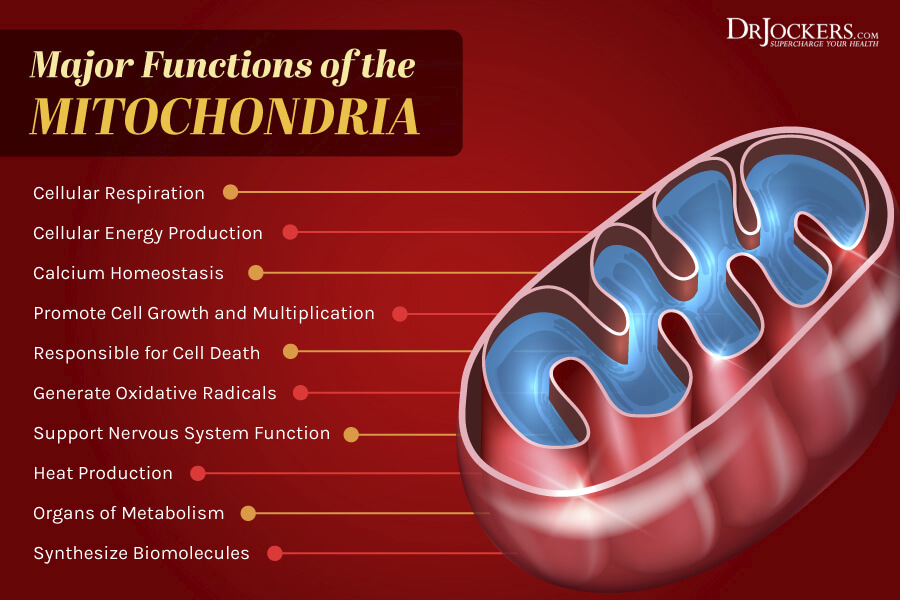
The Role of Mitochondria
With the exception of red blood cells, mitochondria are unique organelles contained in every cell of the human body and contain its own DNA (6). Along with generating 90% of cellular energy in the form of ATP (adenosine triphosphate), mitochondria are involved in major metabolic functions of the human body. (7)
Mitochondria are found in varying concentrations in different tissues in the body and are specialized for the purpose of that tissue. For example, mitochondria contained in the liver are designed to convert ammonia into a less toxic waste substance known as urea in a series of reactions (7). Analysis of the breast muscle of chickens compared to the actively flying pigeon observed that the pigeon actually had a higher concentration of mitochondria in the breast muscle (8).
Both examples represent the differentiation of mitochondria and signify how both genetic and environmental factors influence mitochondria function.
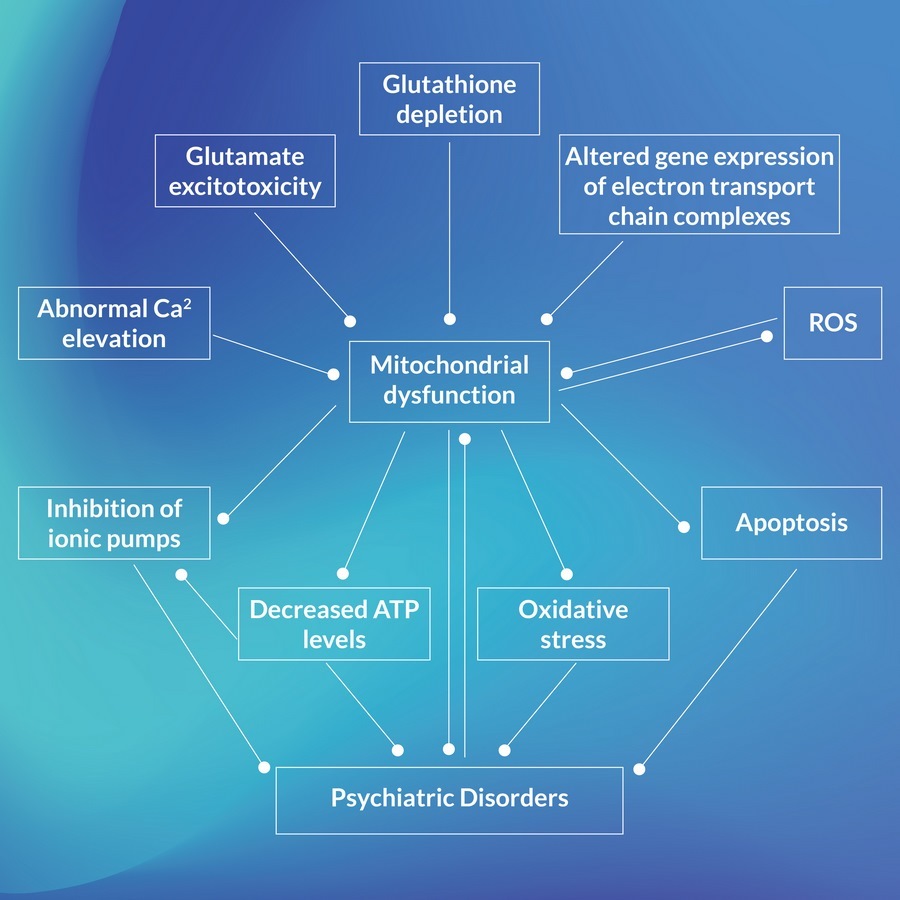
Physiological Effects of the Mitochondria:
The healthy function of mitochondria is essential to life sustaining metabolic processes including: (1, 5)
- Regulating ion concentrations such as calcium buffering critical to intracellular communication
- Maintain roles in fluctuating lipid levels
- Synthesizing products necessary for the transportation of glucose and insulin
- Providing sufficient energy for blood flow to and within the heart
- Regulating the removal of cellular damage or apoptosis if condition is deleterious enough to the mitochondrion’s function
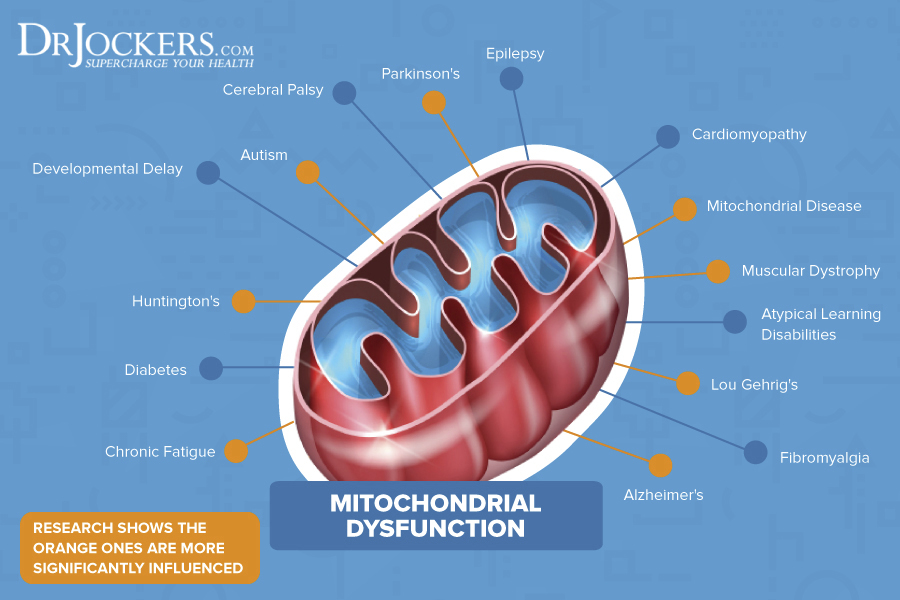
Mitochondria Dysfunction and Health:
Now that research has enlightened our concept of how the mitochondria are more than just energy generators, the medical community now has a new field of research to investigate how mitochondria functional defects adversely affect human health.
Currently, mitochondrial dysfunction is characteristic by a variety of metabolic illnesses and is not categorized as a disease (9).
Multiple Sclerosis:
Known as a neuroimmune disease, patients with multiple sclerosis frequently have impaired ATP synthesis. The lack of ATP is evidence of malfunctioning mitochondria. Also evident in most patients with multiple sclerosis is chronic oxidative stress.
Oxidative stress leads to severe health complications by producing excessive free radicals with a goal to complete demolition work to the structure of cells and inhibit their function. Mitochondria are primary targets of oxidative damage because they are the main sites of cellular respiration which free radicals may be generated in high amounts.( 9)
Reactive oxygen species (ROS) is an example of a powerful type of free radical that is also a necessary evil. ROS is an important key player in the function of cells but excessive amounts deplete beneficial antioxidants such as vitamin C and create destructive changes to the structure of the mitochondrion. The systemic or whole body inflammation seen in multiple sclerosis is believed to largely result from oxidative stress from excess pro-oxidants known as free radicals. (9)
Autism:
Free radical production and damage is not the only factor to blame in illnesses associated with mitochondria dysfunction. A major implication in the pathogenesis of autism is the transfer of inflammatory signals across the blood brain barrier (9).
 A Leaky Central Nervous System
A Leaky Central Nervous System
Inflammation of the central nervous system can be activated by an autoimmune response. As a consequence, specific biomarkers have been noted to “leak” away from the central nervous system causing disruption to both the brain and gastrointestinal tract. These inflammatory signals deplete the antioxidant levels associated with healthy function of mitochondria in the brain and intestines.
Like a game of Pacman, if the antioxidants are spending their time trying to neutralize the compounds causing inflammation that are typically not present, they are not fulfilling their originally designed purpose within the mitochondria. For example, carnitine is an essential amino acid required for producing ATP in the mitochondria. Individuals with autism have been consistently found to have reduced levels of carnitine. (9)
Abnormal Glutathione Pathways
Glutathione is another powerful antioxidant present in abundance in the brain. The brains of autistic children have been found to contain abnormal glutathione producing pathways and reduced glutathione concentrations.
In fact, researchers are directly able to correlate the levels of glutathione concentrations and oxidative stress to the severity of symptoms associated with autism. (9)
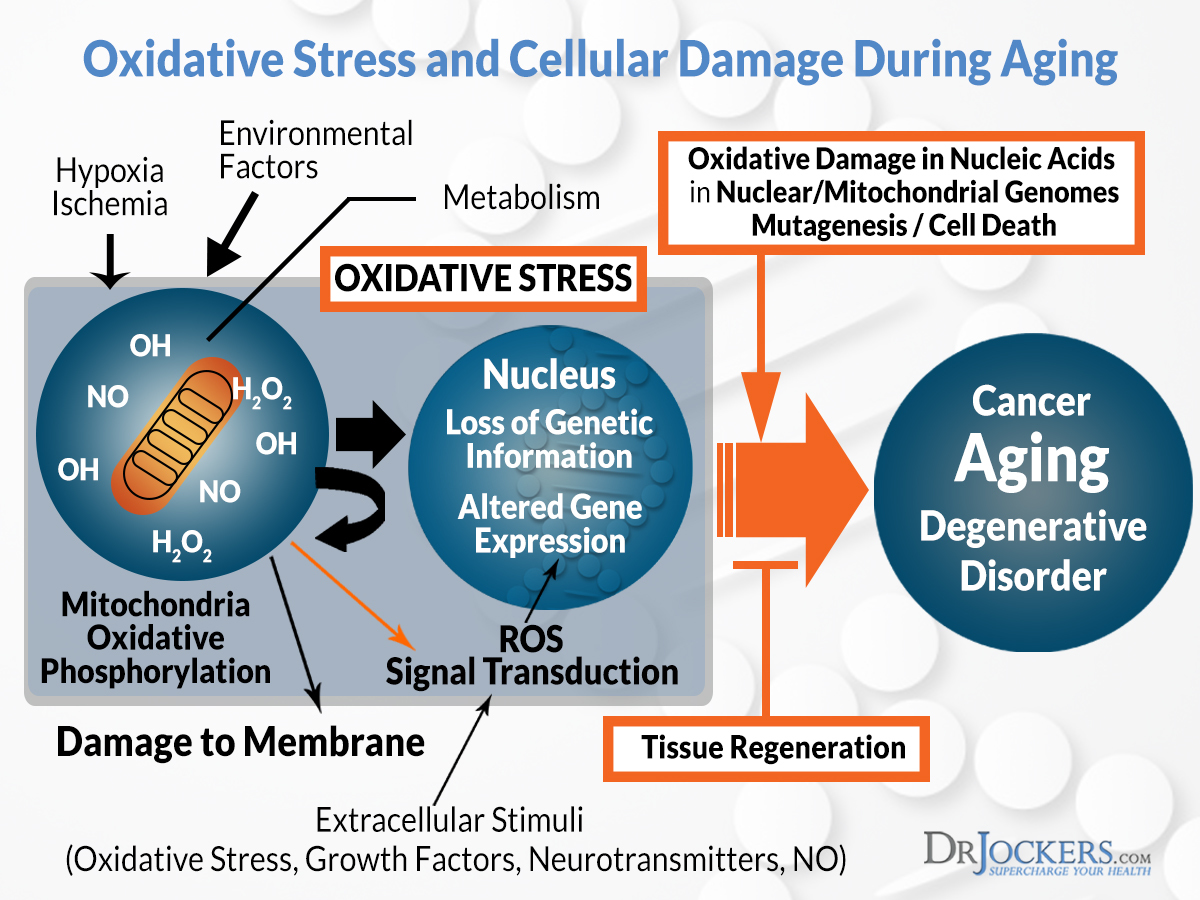
Bipolar Disorder:
Known as a depressive illness, bipolar disorder affects an individual’s mood and behavior. Symptoms of bipolar disorder include an extreme feeling of happiness or sadness, irritability, difficulty sleeping and the inability to maintain attention (10).
Unfortunately, individuals with bipolar disorder are at a higher risk of other illnesses such as ulcerative colitis. Although the development of the illness is still highly scrutinized, researchers have detected high levels of oxidative stress in these patients. Like adding lighter fluid to a flame, the oxidative stress present exacerbates any health complications present and creates new problems.
An increase in both reactive oxygen species and similar nitrogen species are often present in cases of chronic oxidative stress. With an increased presence of our body’s enemies, the human body fights back using its own defense system of antioxidants. Just as glutathione levels are found depleted in autistic individuals, patients battling other illnesses linked to mitochondria dysfunction including depression and Parkinson’s disease are influenced by significantly low levels of glutathione and thioredoxin systems (9).
Not only is glutathione a powerful antioxidant but the thioredoxin system is a defense system which aids in the removal of both reactive oxygen species and nitrogen species (2). Combined with glutathione, the two system’s combined efforts are highly efficient at limiting free radical damage and oxidative stress. It is as if Muhammad Ali and Mike Tyson have teamed up to defeat two mob leaders in a boxing match.
Chronic Fatigue and Fibromyalgia:
Patients with chronic fatigue syndrome (CFS) and fibromyalgia have visibly detectable changes in the structure of the mitochondria. Remember, the mitochondria are composed of different proteins and lipids which contribute to the membranes by which it is made up (1). The structures of these membranes are highly significant because they help maintain the life cycle of the mitochondria when it grows, splits or combines with another mitochondria.
Also apparent along one of the membranes in the mitochondria is the electron transport chain. As you now know, the electron transport chain is responsible for oxidative phosphorylation which is the process that creates ATP. Seen in CFS and fibromyalgia, the abnormal mitochondria structure results in a decrease in ATP synthesis (9).
Type-2 Diabetes:
Unfortunately, the perplexity of mitochondria dysfunction and type-2 diabetes puzzles the medical community. Questions have been raised whether mitochondria dysfunction may often times be the cause of type-2 diabetes. At the very least, the physiology of those patients with the condition exacerbates the effects of mitochondria dysfunction (7, 8).
Metformin, a commonly prescribed drug to treat diabetes, is actually known to induce mitochondria dysfunction and trigger problems that give rise to the development of diabetes (1). Basically, if you are taking metformin then you have been prescribed a medicine that is purposefully created to keep your body in a diabetic condition.
Cancer:
Associated with almost every known health problem, cancer is also correlated with mitochondria dysfunction. A site of high rates of respiration, tumor growth increases. Also as a result of the high rate of respiration, there is an increased risk of producing free radicals which can react with and harm the mitochondria’s own DNA.
As a result, common mitochondrial DNA mutations that occur increase the development of lung cancer, breast cancer and renal cell carcinoma. (1)
Heart Disease:
Heart failure has also been linked to mitochondria dysfunction. As we all know, the heart requires a constant supply of energy in the form of ATP to perform efficiently. Associated with mitochondria related myopathy, the heart is a critical organ that is affected by muscle weakness from defected mitochondria.
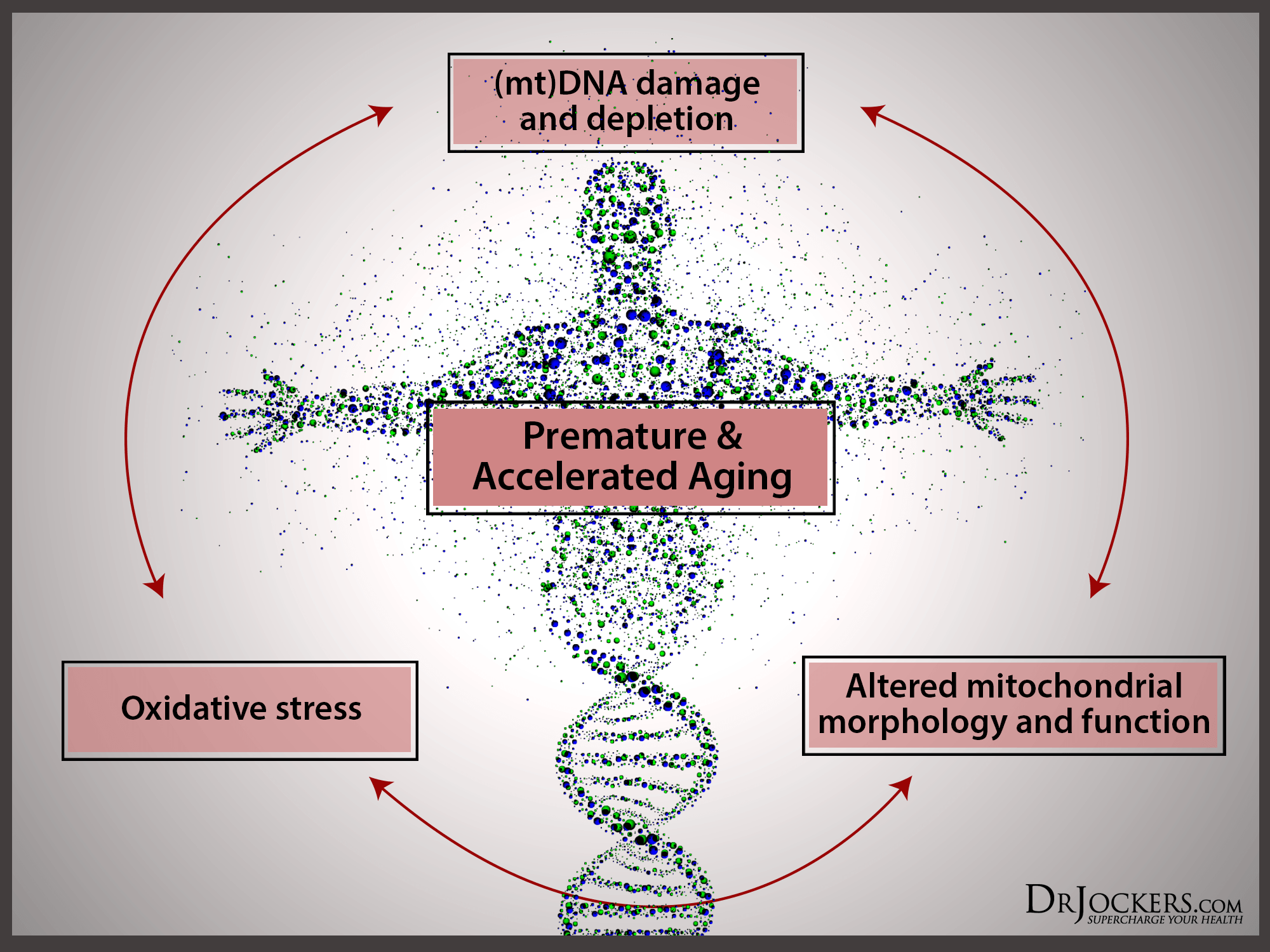 How To Maintain Mighty Mitochondria
How To Maintain Mighty Mitochondria
Improving the function of your mitochondria can be as simple as making lifestyle changes. Certain strategies have been shown to treat symptoms associated with defected mitochondria. You can use these techniques beginning today to help you maintain mighty mitochondria.
Exercise Daily
Exercise can strengthen the performance of mitochondria in all areas of the body. Not only can exercise reduce oxidative stress when utilized appropriately, but exercise can increase mitochondrial activity by improving oxygen flow and blood pH (1).
As was evident in the comparison of the breast muscle of pigeons compared to chickens, individuals who run frequently have also been found to have a higher amount of functioning mitochondria than those who live sedentary lifestyles. (6, 8)
Intermittent Fasting and Mitochondria
When the body fasts, malfunctioning mitochondria can become what is called “purged” in a process known as autophagy or specifically, mitophagy (1, 3). Autophagy is a highly important capability for mitochondria to maintain because this ability enables the mitochondria to remove unwanted and damaged debris, accumulated both reactive oxygen and nitrogen species as well as unfolded proteins which no longer serve a purpose and can create virus like problems.
The loss of mitochondria to undergo autophagy has been linked to an increase risk of cancer, Parkinson’s disease, Huntington’s disease, Alzheimer’s disease, and decreased immunity (3).
Ketogenic Diet to Fuel Your Mitochondria
A ketogenic diet which is rich in fat and low in carbohydrates has been used to suppress symptoms of muscle weakness and abnormal organ function associated with mitochondria dysfunction. The purpose of consuming a ketogenic diet is to change the metabolic state by which a body utilizes a specific food source for energy.
Ketones are alternative energy compounds which fuel cells when limited carbohydrates are available. Whereas carbohydrates use the electron transport chain within healthy mitochondria for energy production, fats are broken down by an entirely different process known as the TCA cycle (1). You may have just received a knot in your stomach if you remember the complexity of this process from your biology class.
The TCA cycle is an efficient energy pathway that the body can use to circumvent defected mitochondria. So effective, a ketogenic diet has been used to treat epilepsy which is a symptom of abnormal mitochondria in the hippocampus region of the brain. A ketogenic diet may also have therapeutic potential in alleviating symptoms associated with mitochondrial myopathy which prevents with a variety of symptoms of which all individuals have muscle weakness. (1)
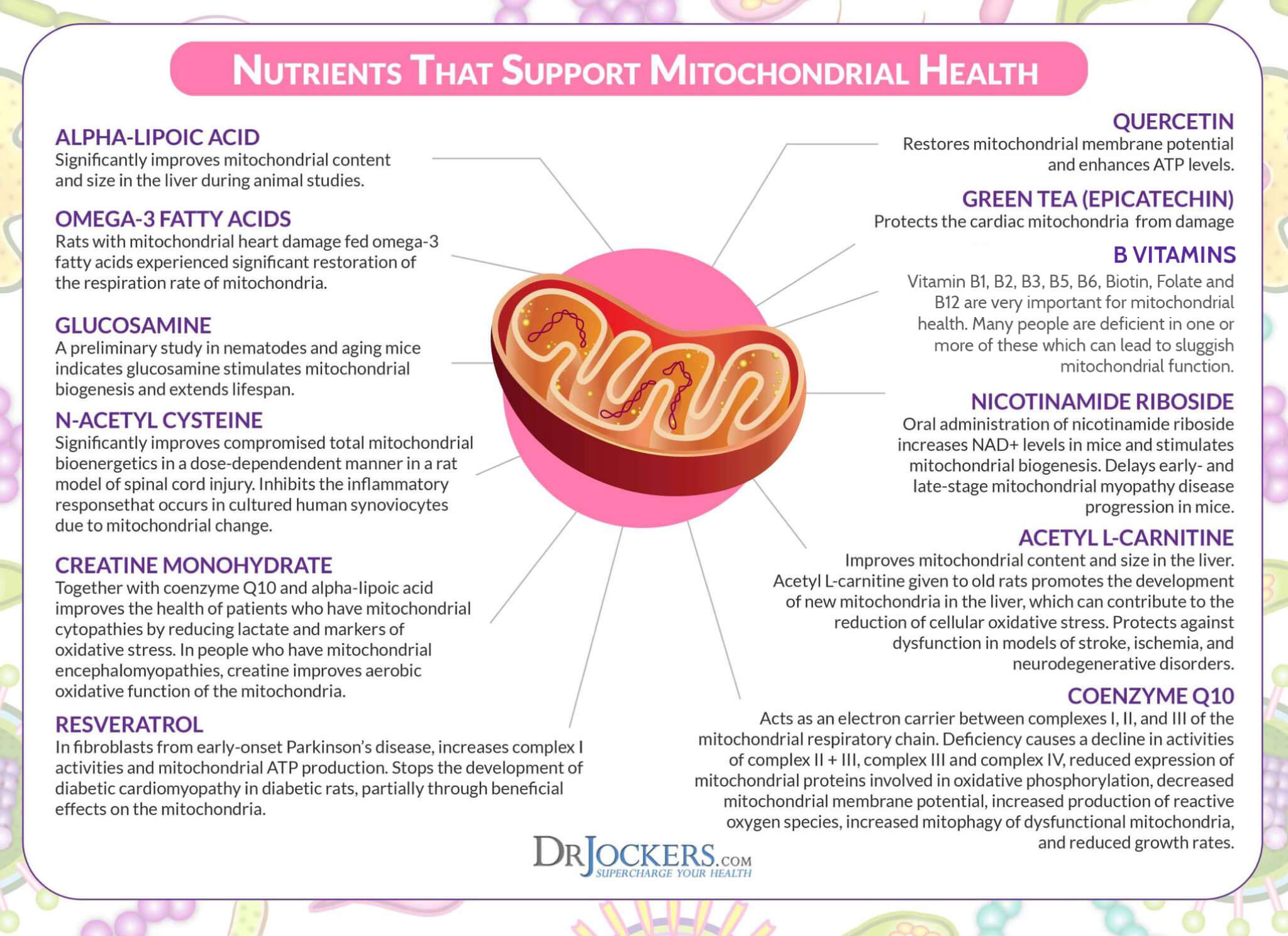
Nutritional Supplementation:
The health of our mitochondria depends on our daily diets and the nutrients which we feed these small health promoting powerhouses. The structure by which mitochondria are designed to successfully create ATP is highly reliant on various types of structural proteins, enzymes and other key vitamins which can be supplemented with your diet. The following nutrients have been shown to treat mitochondria dysfunction: (1, 4, 6, 9)
Acetyl-carnitine: Acetyl-carnitine is produced by the body but can also be found in red meat. This amino acid is involved in transporting compounds and also stimulates glutathione production.
B Vitamins: Various B vitamins have been shown to play a critical role in mitochondria function such as biotin and vitamin B-12. B vitamins are highly specialized antioxidants and increase the synthesis of other strong antioxidants such as glutathione.
Alpha-Lipoic Acid: Alpha-lipoic acid has been especially shown to improve mitochondrial dysfunction in the brain and can improve cognitive ability.
Coenzyme Q10: Coenzyme Q10 (CoQ) is not only an antioxidant but it is also an essential component to the electron transport chain within the mitochondria. In other words, without CoQ10, there is no synthesis of ATP and therefore a defected mitochondrion. Oxidative stress can cause the mitochondrion to over consume any available antioxidants and lead to a deficiency. Depending on the severity of symptoms, CoQ10 supplementation has been shown in studies to help with symptoms associated to CoQ deficiency.
My favorite supplement containing clinical doses for all of these key nutrients for mitochondrial health is Mito Support here.
Mitochondrial Biogenesis
Mitochondrial biogenesis is the process by which new mitochondria are formed. Researchers have only scraped the surface at understanding the series of cell signals that must occur in order for a mitochondria to either split into two known as fission or form a larger mitochondria when two combine contents in the process of fusion. What is understood is that several environmental influences control the rate and ability at which mitochondria grow and divide including: (8)
- Exercise
- Oxidative Stress
- Temperature
- Caloric restriction
The failure of mitochondrial biogenesis to occur has been implicated as a leading factor for many metabolic problems including myopathy, diabetes, Alzheimer’s disease as well as age related complications (1, 8). If the medical community is able to control the signals that enable mitochondria to grow and divide, they might also be able to control the severity of symptoms associated with mitochondrial dysfunction.
Human clinical trials remain to be conducted but successful treatment of animals utilizing a strategy of mitochondrial biogenesis to treat metabolic conditions shows positive results and may serve as a possible therapy to treating mitochondria dysfunction in the future.
Summary
If you learn only one thing about your health and mitochondria dysfunction, learn this. Oxidative stress can impair the function of mitochondria. Exposing your body to environmental contaminants in food, water, air, personal care products and depriving your body of essential nutrients are lifestyle risk factors that you can limit.
Feeding oxidative stress promotes further damage to mitochondria which in turn exacerbates illness and cancer. Left untreated, different illnesses and cancers will continue to cause oxidative stress and therefore completes a vicious cycle of deteriorating health.
Don’t fall prey to such a health consuming cycle. Promote a healthier future by reducing your risk of mitochondria dysfunction and master the health and performance of your mitochondria now.
If you want to work with a functional health coach, I recommend this article with tips on how to find a great coach. Our website offers long-distance functional health coaching programs with our world-class team of health coaches. For further support with your health and other goals, just reach out—our fantastic coaches are here to support your journey.

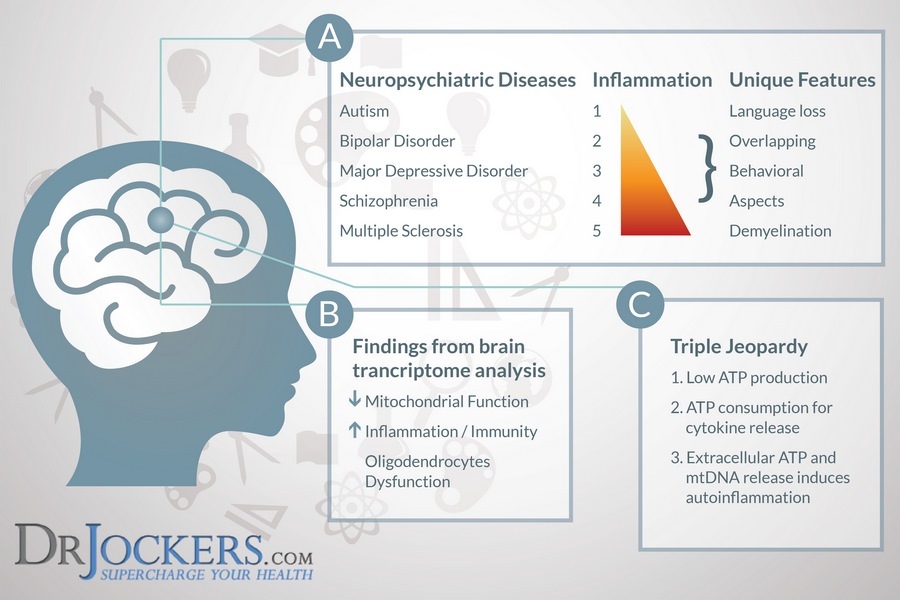


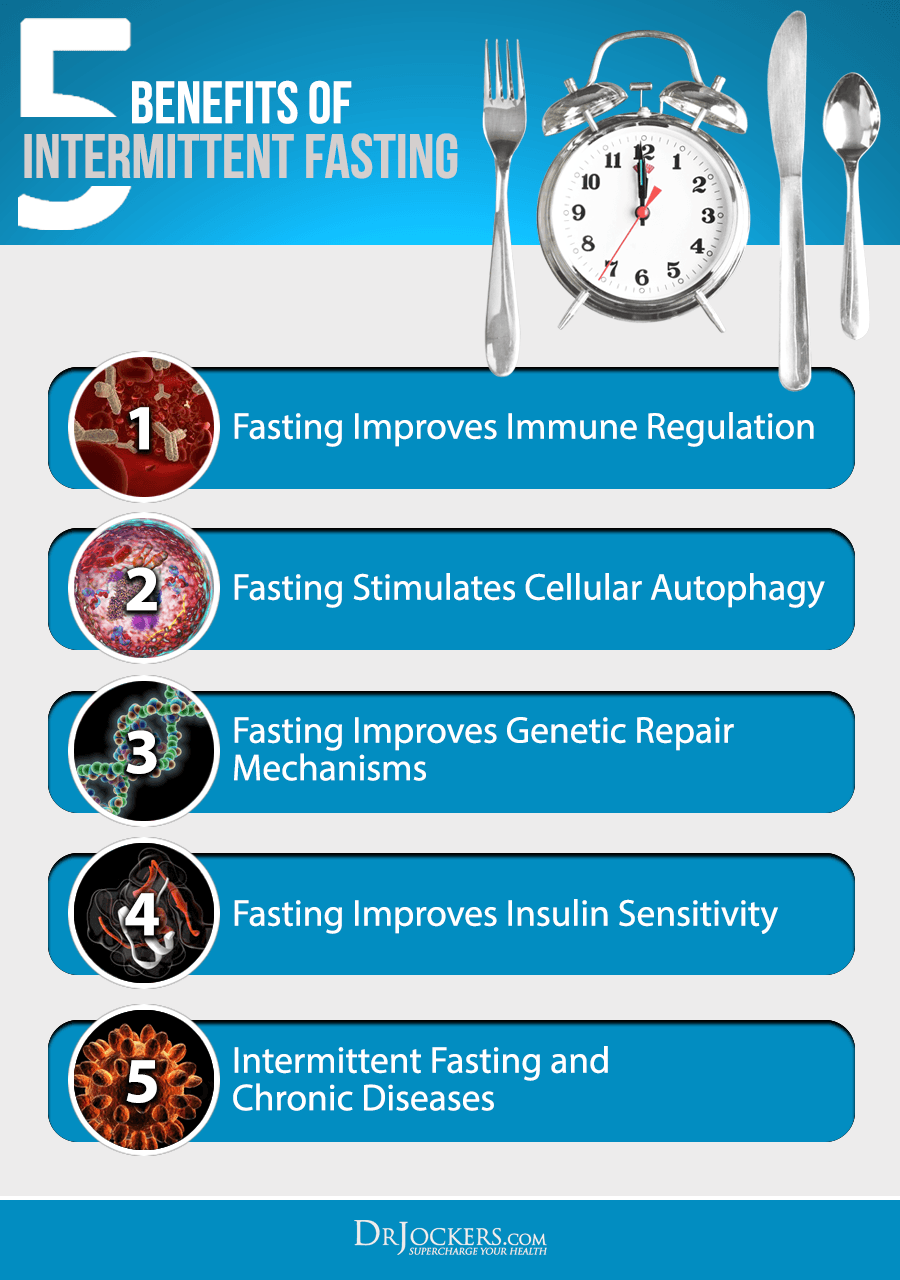
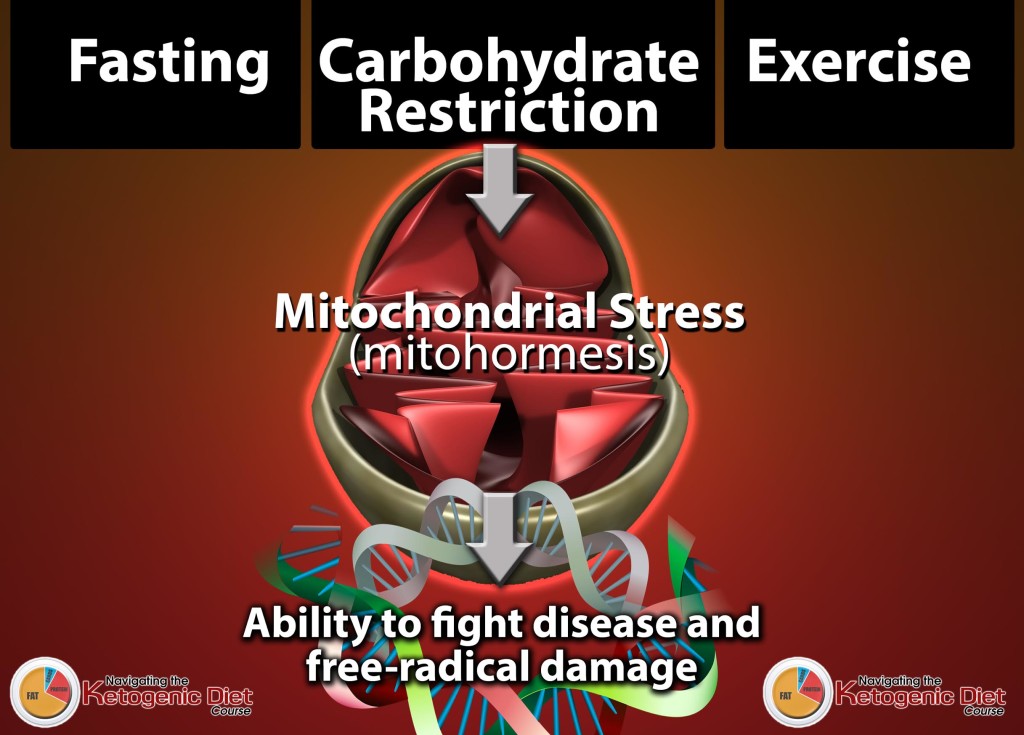






Can you reverse dysfunction if it was due to medication? I developed neuropathy after taking an enormous array of meds after a complicated and painful hip revision. My pain doctors want to put me on meds like Cymbalta and Lyrica because that is the protocol for neuropathy. However, my family doctor believes that the medication that I was on for only 6 months pushed me beyond my limit and caused the neuropathy.
I was on Oxycodone, Oxycontin, Valium, Zofran, Clonidine, Methocarbamol, Suboxone, etc. Over the course of four months. I was off all of the meds for a week before developing a UTI. I was put on Bactrim and that is when the burning skin and anxiety started. It passed in a week. It came back eight months later when I took antibiotics for my acne. It passed again and then came back four months later after starting Nucynta and another antibiotic. I stopped all rx meds six weeks ago and am taking supplements for mitochondria.
Is this reversible? The symptoms are lessening and it has been three weeks of supplementing with L-Carnitine, alpha lipoic acid, methylated vitamin B , nadh, d-ribose , and vitamins C and D.
So sorry to hear that!! Great to hear the symptoms are getting better and yes I believe you can get much better. Praying for you!
Wow! I thought Metformin was one of the more harmless diabetes drugs!
Yes Mary Ann, but all medications have side effects and should be taken with caution.
OMG…i’m afraid I may have mitochondrial dysfunction in addition to adrenal fatigue. I don’t have the chronic illnesses you mentioned, but after extensive reading on this subject, I have some of the symptoms of MD…btw, there is a connection between adrenal fatigue and mitochondrial dysfunction. The worst part of it is there is no cure…and am alone to deal with this. Pls help!
Hey Robyn, I highly recommend that you work with a functional health practitioner. This person will get to the root cause of the problems and customize a specific plan for you. This article has specific ways that you can boost the health of your mitochondria.
Thanks, Dr.J…I do have an ND I work with, alas he moved to Toronto. I want to get the OAT test done, but am afraid it will give TMI. I can’t handle knowing when I will die, as these tests are accurate and scary.